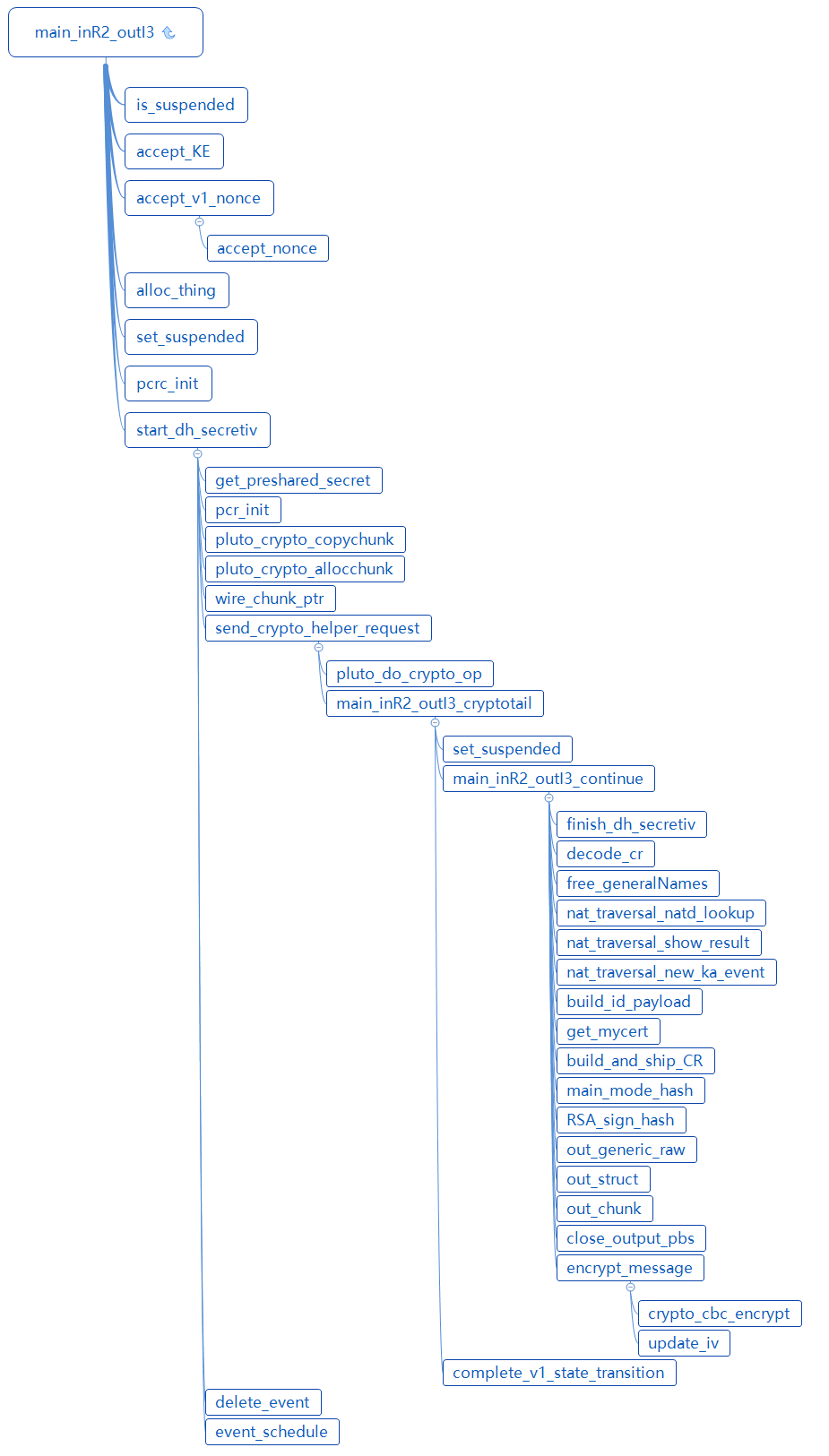1
2
3
4
5
6
7
8
9
10
11
12
13
14
15
16
17
18
19
20
21
22
23
24
25
26
27
28
29
30
31
32
33
34
35
36
37
38
39
40
41
42
43
44
45
46
47
48
49
50
51
52
53
54
55
56
57
58
59
60
61
62
63
64
65
66
67
68
69
70
71
72
73
74
75
76
77
78
79
80
81
82
83
84
85
86
87
88
89
90
91
92
93
94
95
96
97
98
99
100
101
102
103
104
105
106
107
108
109
110
111
112
113
114
115
116
117
118
119
120
121
122
123
124
125
126
127
128
129
130
131
132
133
134
135
136
137
138
139
140
141
142
143
144
145
146
147
148
149
150
151
152
153
154
155
156
157
158
159
160
161
162
163
164
165
166
167
168
169
170
171
172
173
174
175
176
177
178
179
180
181
182
183
184
185
186
187
188
189
190
191
192
193
194
195
196
197
198
199
200
201
202
203
204
205
206
207
|
static stf_status
main_inR2_outI3_continue(struct msg_digest *md
, struct pluto_crypto_req *r)
{
struct state *const st = md->st;
int auth_payload = st->st_oakley.auth == OAKLEY_PRESHARED_KEY
? ISAKMP_NEXT_HASH : ISAKMP_NEXT_SIG;
pb_stream id_pbs;
bool send_cert = FALSE;
bool send_cr = FALSE;
generalName_t *requested_ca = NULL;
cert_t mycert = st->st_connection->spd.this.cert;
finish_dh_secretiv(st, r);
if(!r->pcr_success) {
return STF_FAIL + INVALID_KEY_INFORMATION;
}
decode_cr(md, &requested_ca);
if(requested_ca != NULL)
{
st->hidden_variables.st_got_certrequest = TRUE;
}
send_cert = st->st_oakley.auth == OAKLEY_RSA_SIG
&& mycert.type != CERT_NONE
&& ((st->st_connection->spd.this.sendcert == cert_sendifasked
&& st->hidden_variables.st_got_certrequest)
|| st->st_connection->spd.this.sendcert==cert_alwayssend
|| st->st_connection->spd.this.sendcert==cert_forcedtype);
doi_log_cert_thinking(md
, st->st_oakley.auth
, mycert.type
, st->st_connection->spd.this.sendcert
, st->hidden_variables.st_got_certrequest
, send_cert);
send_cr = !no_cr_send && send_cert && !has_preloaded_public_key(st);
DBG(DBG_CONTROL
, DBG_log(" I am %ssending a certificate request"
, send_cr ? "" : "not "));
free_generalNames(requested_ca, TRUE);
#ifdef NAT_TRAVERSAL
if (st->hidden_variables.st_nat_traversal & NAT_T_WITH_NATD) {
nat_traversal_natd_lookup(md);
}
if (st->hidden_variables.st_nat_traversal) {
nat_traversal_show_result(st->hidden_variables.st_nat_traversal
, md->sender_port);
}
if (st->hidden_variables.st_nat_traversal & NAT_T_WITH_KA) {
nat_traversal_new_ka_event();
}
#endif
{
struct isakmp_ipsec_id id_hd;
chunk_t id_b;
build_id_payload(&id_hd, &id_b, &st->st_connection->spd.this);
id_hd.isaiid_np = (send_cert)? ISAKMP_NEXT_CERT : auth_payload;
if (!out_struct(&id_hd
, &isakmp_ipsec_identification_desc
, &md->rbody
, &id_pbs)
|| !out_chunk(id_b, &id_pbs, "my identity"))
return STF_INTERNAL_ERROR;
close_output_pbs(&id_pbs);
}
if (send_cert)
{
pb_stream cert_pbs;
struct isakmp_cert cert_hd;
cert_hd.isacert_np = (send_cr)? ISAKMP_NEXT_CR : ISAKMP_NEXT_SIG;
cert_hd.isacert_type = mycert.type;
openswan_log("I am sending my cert");
if (!out_struct(&cert_hd
, &isakmp_ipsec_certificate_desc
, &md->rbody
, &cert_pbs))
return STF_INTERNAL_ERROR;
if(mycert.forced) {
if (!out_chunk(mycert.u.blob, &cert_pbs, "forced CERT"))
return STF_INTERNAL_ERROR;
} else {
if (!out_chunk(get_mycert(mycert), &cert_pbs, "CERT"))
return STF_INTERNAL_ERROR;
}
close_output_pbs(&cert_pbs);
}
if (send_cr)
{
openswan_log("I am sending a certificate request");
if (!build_and_ship_CR(mycert.type
, st->st_connection->spd.that.ca
, &md->rbody, ISAKMP_NEXT_SIG))
return STF_INTERNAL_ERROR;
}
#ifdef TPM
{
pb_stream *pbs = &md->rbody;
size_t enc_len = pbs_offset(pbs) - sizeof(struct isakmp_hdr);
TCLCALLOUT_crypt("preHash", st,pbs,sizeof(struct isakmp_hdr),enc_len);
tpm_findID(pbs, &id_pbs);
}
#endif
{
u_char hash_val[MAX_DIGEST_LEN];
size_t hash_len = main_mode_hash(st, hash_val, TRUE, &id_pbs);
if (auth_payload == ISAKMP_NEXT_HASH)
{
if (!out_generic_raw(ISAKMP_NEXT_NONE
, &isakmp_hash_desc
, &md->rbody
, hash_val, hash_len, "HASH_I"))
return STF_INTERNAL_ERROR;
}
else
{
u_char sig_val[RSA_MAX_OCTETS];
size_t sig_len = RSA_sign_hash(st->st_connection
, sig_val, hash_val, hash_len);
if (sig_len == 0)
{
loglog(RC_LOG_SERIOUS, "unable to locate my private key for RSA Signature");
return STF_FAIL + AUTHENTICATION_FAILED;
}
if (!out_generic_raw(ISAKMP_NEXT_NONE
, &isakmp_signature_desc
, &md->rbody
, sig_val
, sig_len
, "SIG_I"))
return STF_INTERNAL_ERROR;
}
}
if (!encrypt_message(&md->rbody, st))
return STF_INTERNAL_ERROR;
return STF_OK;
}
|

